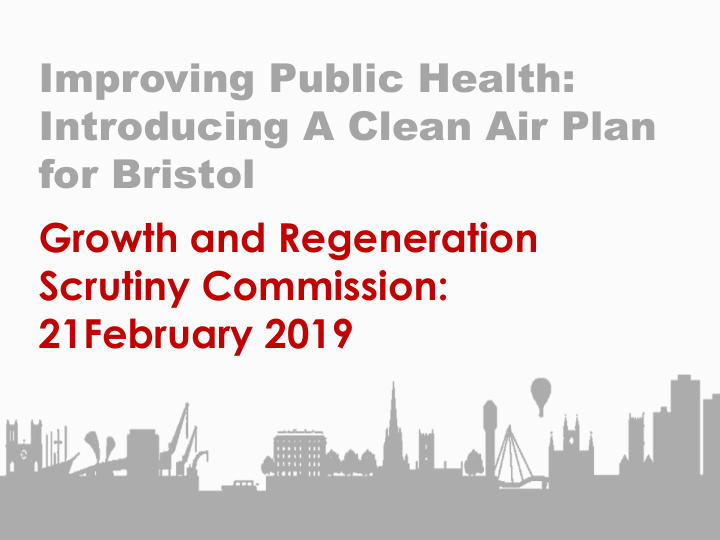



INITIATIVE – BUSINESS WEST Barra Mac Ruairí Improving Public Health: Introducing A Clean Air Plan for Bristol Growth and Regeneration Scrutiny Commission: 21February 2019
INITIATIVE – BUSINESS WEST Barra Mac Ruairí Timeline of work carried out to date Early 2017 - Feasibility study approved for a CAZ, project team set up, Jacobs awarded the work July 2017 - BCC received a Government Direction to deliver compliant air quality in the shortest possible time Late 2017- Project scope moves from a Feasibility Study to a Clean Air Plan with the main part being a Clean Air Zone March 2018 - Strategic Outline Case ( SOC ) submitted and approved at Cabinet June 2018 - Project transitions from an Air Quality Feasibility study to a major transport project
SOC; 5 options INITIATIVE – BUSINESS WEST Barra Mac Ruairí 4 x charging and 1 x non-charging options (plus a benchmark option; CAZ D with no complementary interventions), approved to be modelled from an original list of 20 options and approved at Cabinet in March 2018; 1. A Non-Charging Clean Air Zone with complementary non- charging interventions, including a potential diesel car exclusion zone. 2. A Charging Clean Air Zone (Medium size, Class C – all vehicles except cars) with complementary interventions 3. A Charging Clean Air Zone (Medium size, Class D – all vehicles) with complementary interventions 4. A Charging Clean Air Zone (Small size, Class C – all vehicles except cars) with complementary interventions 5. A Charging Clean Air Zone (Small size, Class D – all vehicles) with complementary interventions.
SOC - Boundaries 2 boundary areas under consideration; medium and small.
INITIATIVE – BUSINESS WEST Barra Mac Ruairí SOC - Mitigation Measures ‘Long list’ of 70 mitigation measures (non charging ) being developed. Measures include; - Scrappage scheme (not currently proposed to be funded by government) - Mobility Credits - Targeted signals measures ; using traffic signals to ensure traffic flows quicker through busier transport corridors. - Subsidized bus services - Clean vehicle 0% interest loans - Expansion of “Smarter Choices” Programme - Bus priority scheme
INITIATIVE – BUSINESS WEST Barra Mac Ruairí Modelling results; two initial options 1) Small area diesel car ban with bus/taxi fleet improvement to Euro6. Exceedances in 2021 at Rupert Street (42.84 µg/m³), Upper Maudlin Street (45.4 µg/m³), Queens Road, (43.0 µg/m³), Church Road (45.2 µg/m³). Results show displacement is an issue. Fully compliant by 2023 (with the exception of the north section of Upper Maudlin St which would be compliant by 2024). 2) Medium CAZ D with complementary measures. Exceedances in 2021 at Rupert Street (46.09 µg/m³), Upper Maudlin Street (52.4 µg/m³), Park street (40.5 µg/m³), Queens Road, (47.9 µg/m³), Newfoundland Way (41.4 µg/m³), Church Road (45.6 µg/m³). Compliant by 2027 (with the exception of the north section of Upper Maudlin St which would be compliant by 2030).
Negative impacts of initial options • Disproportionate impact on low income households. • Cannot reach compliance by 2021 without significant exceedances. • Diesel ban would only be able to operate under restricted hours due to the limits on what can be achieved through a TRO, this reduces the effectiveness (modelling was for a 24hr ban) but also the impact. • Diesel ban shows some increases in road traffic mainly outside of the Small CAZ boundary; namely the A369 and the iconic Clifton Suspension Bridge. • Concerns of impact on local businesses and the socio-economic impacts.
INITIATIVE – BUSINESS WEST Barra Mac Ruairí Economic Case summary “ Affordability impacts are adverse across the full range of relevant socio-economic and business groups for both options. Impacts are disproportionately felt by the most income deprived communities ”. (Extract from; BCC CAZ OBC Economic Case January 2019, p.44 Section 3.12)
Income Deprivation Low income households non-compliant car trips into a medium zone.
INITIATIVE – BUSINESS WEST Barra Mac Ruairí Non-charging Option 1 variant • Initial modelling reviewed to see what the impact would be, without a charging CAZ in place, of removing buses, taxis and HGVs emissions from a medium zone • Early indications is that it could be possible to reach compliance by 2025 • Considering projects and interventions to reduce the impact of buses, taxis and HGVs i.e. electric taxis, bio gas buses • Looking into other potential options to further bring forward the compliant year forward without having a negative socio-economic impact by revisiting the ‘long list’ of interventions
Next steps are to agree with Defra: - Way forward - Timescales - OBC development - Shared investment - Collaborative working
Recommend
More recommend